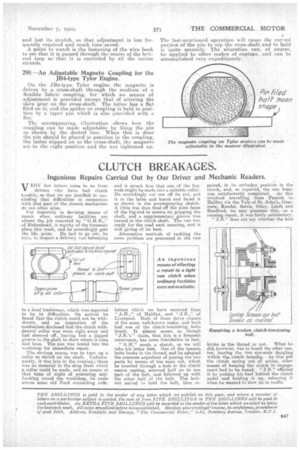CLUTCH BREAKAGES.
Page 31

If you've noticed an error in this article please click here to report it so we can fix it.
Ingenious Repairs Carried Out by Our Driver and Mechanic Readers.
VERY few letters come to us from drivers who have had clutch trouble, so that we are justifiell in son-chiding that difficulties in connection with that part, of the chassis mechanism do not often arise.
For ingenuity in devising means of repair when ordinary facilities are absent the job executed by " G.H.R.," of Birkenhead. is worthy of the foremost place this week, and he accordingly gets the 15s. prize. He had to go out, he says, to inspect a delivery van belonging
to a local tradesman, which was reported to be in difficulties. On arrival he found that the clutch could not be withdrawn, and. an inspection of the mechanism disclosed that the clutch withdrawal collar was worn right away and had sheared off, leaving but a jagged groove in the shaft to show where it once had been. The. fian was towed into the workshop for immediate repair.
The obvious course was to turn up a collar to shrink on the shaft. Unfortunately, it was late in the evening; there was no-material in the shop from which is collar could be made, and no means at that time of night of pr8curing any. Looking round the workshop, he came across some old Ford connecting rods,
and it struck him that one of the bigends might be made, into a suitable collar. He accordingly cut one off its rod, put it in the lathe and bored and faced it as shown in the accompanying sketch. A little was then filed off the joint faces of the big-end to erisare its gripping the shaft, and a supplementary, groove was turned in the clutch shaft. The van was ready for the road next morning, and is still giving of its best.
Alternative methods of tackling the same problem are presented in the two
letters which -we have received from " A.H.," of Halifax, and " J.B.,". of Liverpool. Both of them drive chqssis of the same well-known make, and both had one of the clutch-tensioning bolts break. It almost seems as though " J.B.'s " claim, that this is a frequent occurrence, has some foundation in fact.
" sends a sketch, so we will take his letter first. One of the tension bolts broke in the thread, and he adopted the common expedient of joining the two parts by means of the main nut, which he inserted through a hole in the clutch centre casting, screwed half on to one part of the bolt, and followed up with the other half of the bolt. The locknut .served to hold the bolt, thus .re paired, in its orthodox position in the clutch, and, SO repaired, the rim home • was satisfactorily completed. As this involved travelling from Fenrith to Halifax via the Tare of St. Johres Grasmere, Kendal, Settle, Otley, IAA and Bradford, we may presume that, as a funning repair, it was fairly satisfacthry.
" .LB." does not say whether the bolt broke in the thread or not. What he did, however, was to break the other one, too, Leaving the two eye-ends dangling within the clutch housing. As this put the clutch spring out of action, other means of keeping the clutch in engagement had to be found; " J.13." effected it by putting his heel behind the clutch pedal and holding it up, releasing it when he wanted to slow up in traffic,
































